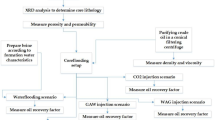TIn order to solve the problem of water lock blockage in the wellbore of Daniudi gas field, the main surfactant APG and CG-1, CG-2, WR and other surfactants were used to produce co-energy and synergistic effect through the combination of multiple surfactants. The static properties of the agent were evaluated by measuring the interfacial tension, surface tension and contact Angle of the surfactant system. According to the physicochemical mechanism of the synergistic action of compound surfactants, the water lock of the combination of anionic surfactants and non-ionic surfactants is preferred. A new water unlocking agent system for tight gas reservoirs was developed: APG (0.3%) +CG-1(0.2%) +SYH (0.1%) +KCl (2%). The interfacial tension between the system and simulated oil was 9.61·10-4 mN/m, the surface tension was 18.2 mN/m, and the gas/liquid/solid three-phase contact antenna was 99.4°. Daniudi tight core (core No. 602-14) was used to simulate the process of high temperature and high-pressure water lock damage. The permeability recovery rate after injection of waterproof lock agent is 25.36% compared with water lock damage.











Similar content being viewed by others
References
Yang Y. L. Experimental study on water lock damage Mechanism and Water lock breaking in low permeability reservoir [J]. Journal of Southwest Petroleum University (Natural Science Edition), 2013, 35(03): 137-141.
Yuan B., Wood D. A., Yu W. Stimulation and hydraulic fracturing technology in natural gas reservoirs. Theory and case studies (2012—2015) [J]. Journal of Natural Gas Science & Engineering, 2015, 26: 1508–1509.
Cao Y. C., Qu Z. Q., Guo T. K., et al. Experimental study on damage dechanism of water-based fracturing fluid to reservoir [J]. Journal of Southwest Petroleum University (Natural Science), 2016, 31(2): 87-92.
He L. C., Lan Q., Huang W. A., et al. Preparation and properties of organic slow release microlactic acid efficient plugging remover [J]. Drilling fluid and completion fluid, 2022, 39(02), 259-264.
Xie X. Q., Jiao G. Y., Luo X., et al. Study on the conductivity of acid-eroded fractures in Leikoupo Formation, western Sichuan [J]. Western Exploration Engineering,2022, 34(01), 71-75.
WeiI M. W., Xue Y. Z., Li G. R., et al. Research progress of water lock release technology [J]. Drilling fluid and completion fluid, 2009, 26(06): 65-68+96-97.
Yang D. L., Liu H. S., Wang P. Y., et al. Effect of FHB-10 composite surfactant on the prevention and treatment of water lock injury in low permeability oil and gas reservoirs [J]. Journal of Oil and Gas Technology, 2011, 33(06): 139-142+10-11.
Tomás Eduardo Chávez-Miyauch, Yingda Lu, Abbas Firoozabadi. Low salinity water injection in Berea sandstone: Effect of wettability, interface elasticity, and acid and base functionalities [J]. Fuel, 2020, 263: 116572-116572
He X. Q., Li G. R., Luo H. F., et al. Analysis of industrial application effect of low permeability tight gas exploration and development in Yan ‘an [J]. Contemporary Chemical Industry, 2020, 49(09): 2011-2015.
Liu P. Z., Guo H. K., Zhang X. W., et al. Experimental study on damage mechanism of water sensitive water lock in tight gas reservoir [J]. Bulletin of Science and Technology,2019,35(08):103-108.
An Z. J. Water lock prevention/release technology of “Sangao” tight sandstone gas reservoir in Tarim Oilfield [J]. Oil drilling and production technology, 2019, 41(06): 763-767.
Jiang Y., Yang X. Y., Li Y., et al. Prevention and treatment of water lock injury of tight sandstone gas reservoir in Dabi-Keshen block [J]. Journal of Shenzhen University (Science and Technology Edition), 2017, 34(06): 640-646.
Jia J., Feng L., Xia Z. Y., et al. Prevention and treatment of water lock injury of tight sandstone gas reservoir in Dabi-Keshen block [J]. Journal of Shenzhen University (Science and Technology Edition), 2021, 17(01): 25-28+33+2.
Sun T., Gao D., Zhang H. A New Well Profile for Extended Reach Drilling (ERD)[J]. CMES: Computer Modeling in Engineering & Sciences, 2013, 90(1): 37-45.
Sun T., Gao D., Zhang H. Determination of the Critical Displacement in Ultra-deepwater Drilling[J]. Energy Sources, Part A: Recovery, Utilization, and Environmental Effects, 2012, 34(6): 485-491.
Sun T, Zhang X, Liu S, et al. Annular Pressure Buildup Calculation When Annulus Contains Gas[J]. Chemistry and Technology of Fuels and Oils, 2018, 54(4): 484-492.
Sun T., Zhang H., Gao D., et al. Calculation of the Open-Hole Extended-Reach Limit for an Extended-Reach Well[J]. Chemistry and Technology of Fuels and Oils, 2016, 52(2): 211-217.
Feng X. F., Wu H., Wang Y. F. Laboratory study on water lock damage in low permeability reservoir [J]. Contemporary Chemical Industry, 2019, 48(11): 2626-2629.
Yao M. T., Yuan X. F., Huang L. C., et al. Water lock damage and relief of high temperature and high pressure fractured tight sandstone gas reservoir [J]. Oil and Gas Chemical Industry, 2021, 50(04): 96-99.
Chen X. L., Liang Y., Liu X. Q., et al. Water lock mechanism analysis and identification of gas reservoirs in Eastern Jiangsu [J]. Petrochemical Applications, 2019, 38(05): 54-60.
Diao H. X., Wang Y. X., Xiong C., et al. Study on Influencing factors of water lock damage in low permeability sandstone reservoir [J]. Contemporary Chemical Industry, 2016, 45(08): 1817-1819+1823.
Huang W. A., Lei M., Teng X. Q., et al. Damage mechanism of tight sandstone gas reservoir and optimization of low damage drilling fluid [J]. Drilling fluid and completion fluid, 2018, 35(04): 33-38.
Author information
Authors and Affiliations
Corresponding authors
Additional information
Translated from Khimiya i Tekhnologiya Topliv i Masel, No. 6, pp. 85–90, November – December, 2023.
Rights and permissions
Springer Nature or its licensor (e.g. a society or other partner) holds exclusive rights to this article under a publishing agreement with the author(s) or other rightsholder(s); author self-archiving of the accepted manuscript version of this article is solely governed by the terms of such publishing agreement and applicable law.
About this article
Cite this article
Wang, J., Zhang, D., Xie, G. et al. Study on a New System of Water Unlocking in Tight Sandstone Gas Reservoirs. Chem Technol Fuels Oils 59, 1195–1202 (2024). https://doi.org/10.1007/s10553-024-01635-8
Published:
Issue Date:
DOI: https://doi.org/10.1007/s10553-024-01635-8




